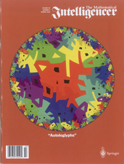The Poincaré hyperbolic disk is a two-dimensional space having hyperbolic geometry defined as the disk , with hyperbolic
metric
 |
(1)
|
The Poincaré disk is a model for hyperbolic geometry in which a line is represented as an arc of a circle whose ends are perpendicular to the disk's boundary (and diameters are also permitted). Two arcs which do not meet correspond to parallel rays, arcs which meet orthogonally correspond to perpendicular lines, and arcs which meet on the boundary are a pair of limits rays. The illustration above shows a hyperbolic tessellation similar to M. C. Escher's Circle Limit IV (Heaven and Hell) (Trott 1999, pp. 10 and 83).
|
|
|
The endpoints of any arc can be specified by two angles around the disk and
. Define
|
(2)
| |||
|
(3)
|
Then trigonometry shows that in the above diagram,
|
(4)
| |||
|
(5)
|
so the radius of the circle forming the arc is and its center is located at
, where
|
(6)
|
The half-angle subtended by the arc is then
|
(7)
|
so
|
(8)
|
The Poincaré hyperbolic disk represents a conformal mapping, so angles between rays can be measured directly. There is an isomorphism between the Poincaré disk model and the Klein-Beltrami model.

A tiling of the Poincaré disk using the words "Poincaré disk" with five pentagons around each vertex appears on the cover of a 2004 volume of the Mathematical Intelligencer (Segerman and Dehaye 2004).